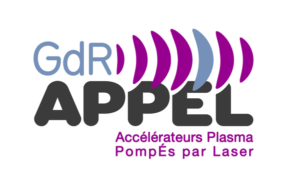Orateur
Description
The concept of the Travelling Wave Tube (TWT) was conceived in 1947 [1], followed by analytical models in the 1950s [2,3,4]. The growing interest of this system takes source with the domain of high power and high frequency microwave devices such as the gyrotrons, the relativistic travelling wave tubes or the free-electron lasers.
The concept of TWT involves utilizing an incident electron beam to amplify the amplitude of an input electromagnetic field through coupling between the beam and a current propagating in a helix.
Applications of TWT include satellite communication systems, an electronic countermeasures or radar systems permitted by a wide instantaneous bandwidth, high gain and light weight.
On the other hand, laser-driven ion acceleration is currently one of the most dynamic research domains due to its conpactness and numerous applications such as isochoric heating, isotope or neutron production, plasma radiography, and nuclear fusion in a fast ignition scheme. The concept involves interacting a high-intensity laser beam with a solid target. The laser beam's pre-pulse creates plasma on the target, and the main pulse accelerates electrons, generating charge separation and a static electric field of several TV/m. This field accelerates protons to a range of MeV to tens of energy. However, the angular divergence of Target Normal Sheath Acceleration (TNSA) is still too high, and the energy distribution of protons is poorly controlled, limiting the application possibilities.
In this context, the idea to implement a system coupled to TNSA was conceived to post-accelerate and focus the proton beam, termed the helical coil [5]. The concept involves retrieving a discharge current, created by the laser-plasma interaction, using a helix. The physics of current propagation in this helix is analogous to coupled transmission systems [2,3]. However, the helical coil is not yet optimized. The current dispersion prevents continuous post-acceleration and focusing of ions along the helix length [6]. Similar issues have been observed in coupled transmission systems, leading to the idea of adding a tube around the helix [4]. This new setup helps reduce current dispersion in the helix. Consequently, we implemented a tube around the helical coil to create a helical coil with tube (HCT) and demonstrated that the HCT bunches the proton beam in energy and increases the energy cut-off. However, post-acceleration is also limited due to proton beam depopulation at the targeted energy, depending on the HCT geometry (radius and pitch). This is why we propose to vary the geometry and consequently the targeted energy of the HCT as a function of the proton propagation axis, which we refer to as the varying helical coil with tube (VHCT).
Références
[1] Rudolf Kompfner. The traveling-wave tube as amplifier at microwaves. Proceedings of the IRE, 35(2) :124–127, 1947.
[2] John Robinson Pierce. Traveling-wave tubes. The bell System technical journal, 29(2) :189–250, 1950.
[3] GS Kino and SF Paik. Circuit theory of coupled transmission systems. Journal of Applied Physics, 33(10) :3002–3008,
1962.
[4] JP Freund, MA Kodis, and NR Vanderplaats. Self-consistent field theory of a helix traveling wave tube amplifier.
IEEE transactions on plasma science, 20(5) :543–553, 1992.
[5] Satyabrata Kar, Hamad Ahmed, Rajendra Prasad, Mirela Cerchez, Stephanie Brauckmann, Bastian Aurand, Giada
Cantono, Prokopis Hadjisolomou, Ciaran LS Lewis, Andrea Macchi, et al. Guided post-acceleration of laser-driven
ions by a miniature modular structure. Nature communications, 7(1) :1–7, 2016.
[6] M Bardon, JG Moreau, L Romagnani, C Rousseaux, M Ferri, F Lefévre, I Lantuéjoul, B Etchessahar, S Bazzoli,
D Farcage, et al. Physics of chromatic focusing, post-acceleration and bunching of laser-driven proton beams in helical
coil targets. Plasma Physics and Controlled Fusion, 62(12) :125019, 2020.
1


